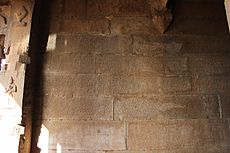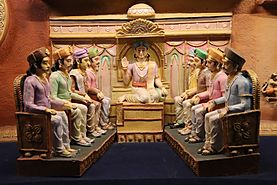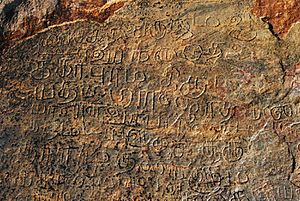Krishnadevaraya facts for kids
Quick facts for kids Krishnadevaraya |
|
|---|---|
| Maharaja-dhirāja Kannada Rajya Rama Ramana Dakshinasamudradhiswara Mooru Rayara Ganda Andhra Bhoja Abhinava-Bhoja Gaubrahmana Pratipalaka |
|
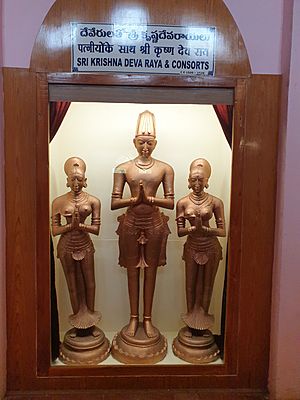
Sculpture of Krishnadevaraya and his wives at Chandragiri Museum
|
|
| Vijayanagara Emperor | |
| Reign | 26 July 1509 – 17 October 1529 |
| Predecessor | Viranarasimha Raya |
| Successor | Achyuta Deva Raya |
| Born | 17 January 1471 Vijayanagara, Vijayanagara Empire (modern day Hampi, Karnataka, India) |
| Died | 17 October 1529 (aged 58) Vijayanagara, Vijayanagara Empire (modern day Hampi, Karnataka, India) |
| Consort | Tirumala Devi Chinna Devi Annapurna Devi |
| Issue |
|
| Dynasty | Tuluva |
| Father | Tuluva Narasa Nayaka |
| Mother | Nagala Devi |
| Religion | Hinduism |

Krishnadevaraya (born January 17, 1471 – died October 17, 1529) was a powerful emperor of the Vijayanagara Empire. He ruled from 1509 to 1529. He was the third ruler of the Tuluva dynasty. Many people consider him one of the greatest rulers in Indian history.
His empire was the largest in India after the Delhi Sultanate became weaker. Krishnadevaraya ruled when the empire was at its strongest. He is seen as a hero by many people in India. He earned many important titles. These include Kannada Rajya Rama Ramana (Lord of the Kannada Empire) and Andhra Bhoja (Scholar of Andhra). He was also called Mooru Rayara Ganda (Lord of Three Kings).
He became the most important ruler in southern India. He defeated the sultans of Bijapur, Golconda, and the Bahmani Sultanate. He also defeated the Gajapatis of Odisha. He was one of the strongest Hindu rulers in India.
Krishnadevaraya's rule was about growing and strengthening his empire. He took control of the land between the Tungabhadra and Krishna rivers in 1512. He also defeated the ruler of Odisha in 1514. He gave big defeats to the Sultan of Bijapur in 1520.
The Mughal Emperor Babur thought Krishnadevaraya was the most powerful ruler in India. He had the largest empire. Portuguese travelers like Domingo Paes and Duarte Barbosa visited his empire. They wrote that the king was a great leader and a skilled general. He even helped wounded soldiers in battle. He often changed his battle plans suddenly. This helped him turn losing fights into victories. His prime minister, Timmarusu, was like a father figure to him. Krishnadevaraya also got advice from the clever Tenali Ramakrishna.
Contents
Early Life of Krishnadevaraya
Krishnadevaraya was the son of Tuluva Narasa Nayaka and his queen Nagamamba. His father was an army commander. He took control of the empire to stop it from breaking apart. He then started the Tuluva dynasty.
Krishnadevaraya married Princess Tirumala Devi from Srirangapatna. He also married Chinna Devi, a famous royal dancer from Kodagu. He had three children: Tirumalamba and Tirumala Raya with Tirumala Devi, and Vengalamba with Chinna Devi. His daughters later married princes from Vijayanagara.
Military Victories
Krishnadevaraya faced several enemies. These included the Bahamani Sultans, who were a constant threat. The Gajapatis of Odisha had also been fighting the empire for a long time. Portugal was a new sea power that controlled much of the sea trade.
Success in the Deccan Region
During Krishnadevaraya's rule, the attacks by the Deccan sultans on Vijayanagar towns stopped. In 1509, his armies fought them. Sultan Mahmud was badly hurt and defeated. Yusuf Adil Shah was killed, and the Raichur Doab was taken over.
Krishnadevaraya then brought Bidar, Gulbarga, and Bijapur back into the Vijayanagar Empire. He earned the title "establisher of the Yavana kingdom." He even released Sultan Mahmud and made him the ruler again. The Sultan of Golconda, Sultan Quli Qutb Shah, was defeated by Timmarusu, Krishnadevaraya's prime minister.
War with Kalinga
The Gajapatis of Odisha ruled a large area. This included Bengal, the Andhra region, and Odisha. Krishnadevaraya's success helped him take his army into Coastal Andhra. This area was controlled by the Gajapati king, Prataparudra Deva.
The Vijayanagar army surrounded the Udayagiri fort in 1512. This fight lasted for a year. The Gajapati army finally broke apart because of hunger. Krishnadevaraya then prayed at Tirupati with his wives.
Next, the Gajapati army was met at Kondaveedu. The Vijayanagara army surrounded it for months. They started to retreat because of many losses. Then, Timmarusu found a secret entrance to the fort's unguarded eastern gate. He launched a night attack. This led to the capture of the fort. Prince Virabhadra, Prataparudra Deva's son, was taken prisoner.
Krishnadevaraya planned to attack Kalinga. But Prataparudra found out and made his own plan. He wanted to defeat Krishnadevaraya at the Kalinganagar fort. However, the clever Timmarusu learned of Prataparudra's plan. He bribed a soldier who had left Prataparudra's service. When the Vijayanagara Empire attacked, Prataprudra was pushed back to Cuttack, the capital of the Gajapati Kingdom.
Prataparudra finally gave up to the Vijayanagara Empire. He gave his daughter, Princess Jaganmohini, in marriage to Krishnadevaraya. Krishnadevaraya returned all the lands the Vijayanagara Empire had captured north of the Krishna River. This made the Krishna river the border between the two kingdoms.
Krishnadevaraya also made friends with the Portuguese in Goa in 1510. The Emperor got guns and Arabian horses from Portuguese traders. He also used Portuguese knowledge to improve the water supply to Vijayanagara City.
Final Conflicts and Death
The empire had many complex friendships and rivalries with the five Deccan sultanates. This meant Krishnadevaraya was always at war. In one campaign, he defeated Golconda. He also captured its commander, Madurul-Mulk. He crushed Bijapur and its sultan, Ismail Adil Shah. He also helped restore the Bahmani sultanate to the son of Muhammad Shah II.
A major victory happened on May 19, 1520. He took Raichur Fort from Ismail Adil Shah. This was a difficult fight where 16,000 Vijayanagara soldiers died. The military leader, Pemmasani Ramalinga Nayudu, was highly praised for his actions during the Battle of Raichur. It is said that 700,000 foot soldiers, 32,600 cavalry, and 550 elephants were used. Portuguese soldiers with firearms helped capture the fort.
Krishnadevaraya was harsh towards the Bahmani generals of Raichur. Many of them lost their lands. Other Muslim kings sent messengers to the emperor after his success. Krishnadevaraya said that if Adil Shah came to him and bowed down, his lands would be returned. This never happened. Krishnadevaraya then led his army north to Bijapur and took it over. He freed three sons of a former Bahmani king. These sons had been held captive by the Adil Shah. He then declared the eldest son as king of the Deccan.
In his last battle, he destroyed the fortress of Gulburga. This was the old capital of the Bahmani sultanate.
In 1524, Krishnadevaraya made his son Tirumala Raya the Yuvaraja (crown prince). But the prince died soon after, possibly poisoned. Krishnadevaraya suspected Timmarusu and had him blinded. Around this time, Krishnadevaraya became ill. He died in 1529. His brother, Achyuta Deva Raya, became the next emperor.
Running the Empire

During his rule, Krishnadevaraya kept a close watch on his ministers. He punished any minister who did wrong. He removed unfair taxes, like the marriage fee. To get more money for the empire, he brought new lands under farming. He ordered some areas to be cleared of forests. He also started a big project to get water for irrigation around Vijayanagar.
Foreign travelers like Paes, Nunez, and Barbosa visited Vijayanagar. They spoke highly of his good government. They also noted how well the people lived during his reign.
Krishnadevaraya believed a king should always rule fairly. He cared deeply about his people's well-being. He traveled widely across the empire every year. During these trips, he personally checked on things. He tried to fix people's problems and punish those who did wrong. He also encouraged economic growth. He said that even if the land was small, kings should build water tanks and canals. This would help the poor and bring wealth and good deeds.
Arts and Literature

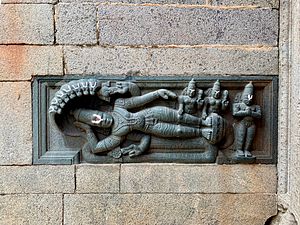
Krishnadevaraya was fair to all languages in his empire. He supported poets and had inscriptions made in Sanskrit, Tamil, Kannada, and Telugu. Krishnadevaraya himself could speak Sanskrit, Tamil, Kannada, and Telugu fluently. The main language of the Vijayanagara court was Kannada.
Krishnadevaraya supported literature in many languages. His rule was a time of great writing in many languages. It is especially known as a golden age for Telugu literature. Many poets in Telugu, Kannada, Sanskrit, and Tamil were supported by the emperor. The king himself wrote an epic Telugu poem called Amuktamalyada. His Sanskrit works include ‘Madalasa Charita’ and ‘Jambavati Kalyana’.
Telugu Literature
Krishnadevaraya's rule is known as the golden age of Telugu literature. Eight Telugu poets were seen as the eight pillars of his literary group. They were known as Ashtadiggajas. Krishnadevaraya himself wrote the epic Telugu poem Amuktamalyada.
During his reign, Telugu culture and literature grew greatly. The emperor was a famous poet himself. In his court, the eight Telugu poets were very important. This time is called the "Prabandha Period" because of the high quality of the prabandha literature created.
- Allasani Peddana is thought to be the greatest. He was called Andhra Kavita Pitamaha (the father of Telugu poetry). His famous work, Svarocisha Sambhava, was given to Krishnadevaraya.
- Nandi Thimmana wrote Parijathapaharanam.
- Dhurjati wrote Kalahasti Mahatyamu.
- Pingali Surana wrote Raghava Pandaviyamu. This work has two meanings, telling stories from both the Ramayana and the Mahabharata.
- Tenali Ramakrishna was a quick-witted courtier. He is still a popular folk figure in India today. He wrote Panduranga Mahatmyamu.
Kannada Literature
Krishnadevaraya supported the Kannada poet Mallanarya. He wrote Veera-shaivamruta. Chatu Vittalanatha wrote Bhagavatha. Timmanna Kavi wrote a praise poem about his king called Krishna Raya Bharata. Vyasatirtha, a great saint, was his Rajaguru (royal teacher). A recently found work, Krishna Deva Rayana Dinachari, is thought to be his personal diary. It shows what society was like during his time.
Purandara Dasa, a famous composer, also explored the Madhwa philosophy. He spent his last years in Hampi. He sang songs in Krishnadevaraya's court.
Tamil Literature
Krishnadevaraya supported the Tamil poet Haridasa. Tamil literature also grew during his reign.
Sanskrit Literature
In Sanskrit, Vyasatirtha wrote several works. Krishnadevaraya himself was a skilled scholar. He wrote Madalasa Charita and Jambavati Kalyana.
Religion and Culture
Krishnadevaraya respected all parts of Hinduism. He encouraged and supported different religious groups and their places of worship. He rebuilt the Virupaksha Temple and other Shiva shrines. He gave land to temples like Tirumala, Srisailam, and Chidambaram.
He gave many valuable gifts to the Tirumala Venkateswara Temple. These gifts included diamond-studded crowns and golden swords. Krishnadevaraya made Venkateshwara his main deity. He visited the temple seven times. Out of about 1,250 temple records, 229 are from Krishnadevaraya. A statue of Krishnadevaraya with his two wives can still be seen at the Tirumala temple complex. He also helped build parts of the Srisailam temple complex.
Krishnadevaraya was officially part of the Sri Vaishnava religion. He wrote a Telugu work about Andal, a Sri Vaishnava female saint. This work was called the Amuktamalyada. Venkata Tathacharya, a Sri Vaishnava leader, was Krishnadevaraya's Rajguru (royal teacher).
See also
 In Spanish: Krishna Deva Raya para niños
In Spanish: Krishna Deva Raya para niños
- Vijayanagara Sri Krishnadevaraya University
- Sri Krishnadevaraya University
- History of Tirumala Venkateswara Temple


